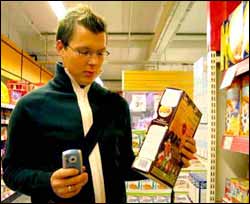Finnish innovation: Mobile phone to facilitate consumers’ wholesome food choices by reading product information from barcodes

A context-based personalized information system for delivering product information to the consumer
The Technical Research Centre of Finland (VTT), together with the University of Kuopio and the Helsinki School of Economics, has developed a prototype for a service that can help consumers in their food choices. Consumers will be able to read product-specific information directly from a package’s barcode using a camera phone, or by using the service at home via the Internet. The service shows the energy and nutrition information of food and also offers the possibility to use a food diary and an exercise calculator. Finnish test groups experienced the pilot system as rewarding.
The communication service system utilises internet and camera phones to offer consumers product-specific information that responds to their interests. Through the service a consumer can collect nutritional information about food products according to his/her interests, irrespective of time or place. VTT has developed and patented a barcode analysis program that enables a camera phone to act as a barcode reader.
The project offers real product-specific information, not only information based on averages. Nutrition information is shown from a typical portion size of the product. The service enables comparisons between products, making a list of favourites and keeping a food diary wherever and whenever one wants. Consumers can also use an exercise calculator and calculate their body mass index. With the exercise calculator consumers can check how long they should exercise in order to burn off consumed food. In addition, consumers can utilise versatile product searches, and advice and background information related to nutrition.
The pilot system was developed for two consumer groups, weight-watchers and those who are lactose intolerant, but it may be expanded to include any consumer group. The system includes information on approximately 700 products from the companies that participated in the project. The system was tested in the Helsinki area and Kuopio. About 100 people participated in the field test and used the service for a few weeks.
Those who participated in the field test liked the idea of the service, because they found the information concerning their own diet very interesting and rewarding. The Internet site was considered interesting and easy to use. The test users were especially happy in the use of personalised information, the nutrition and exercise calculator and the advisory content of the service. The service was used more at home than in a store. However, the usability of a camera phone and the limited amount of product information were considered troublesome. Reading of barcodes should be made easier and the telecommunication connections should be faster.
Alternative business models were developed in the project to assess the commercial potential of the service. There are still challenges to increase the ease of use and to create and maintain required product databases.
There is a need for exploiting of new channels to provide nutrition information as traditional nutrition education, which is based on guiding individuals and groups, is not sufficient to support changes in diet. Consumers wish increasingly more information on the health effects of food products for making decision on their purchases. People are increasingly interested in personalised nutrition information that is directly applicable to themselves. Package labelling can be insufficient or hard to read, and other sources of information may be unattainable especially at the moment it is most needed.
This two-year project is a part of the Fenix technology program of the National Technology Agency of Finland (TEKES) and it will end on 30 June 2005. In addition to TEKES and VTT, the project has received funding from the Finnish Food and Drink Industries’ Federation, Elisa, Fazer Bakeries, Raisio, Sinebrychoff and Valio.
Media Contact
More Information:
http://www.vtt.fiAll latest news from the category: Information Technology
Here you can find a summary of innovations in the fields of information and data processing and up-to-date developments on IT equipment and hardware.
This area covers topics such as IT services, IT architectures, IT management and telecommunications.
Newest articles

New perspectives for material detection
CRC MARIE enters third funding period: A major success for terahertz research: Scientists at the University of Duisburg-Essen and the Ruhr University Bochum have been researching mobile material detection since…

CD Laboratory at TU Graz Researches New Semiconductor Materials
Using energy- and resource-saving methods, a research team at the Institute of Inorganic Chemistry at TU Graz aims to produce high-quality doped silicon layers for the electronics and solar industries….

Study on gene regulation with surprising results
Some sequences in the genome cause genes to be switched on or off. Until now, each of these gene switches, or so-called enhancers, was thought to have its own place…



